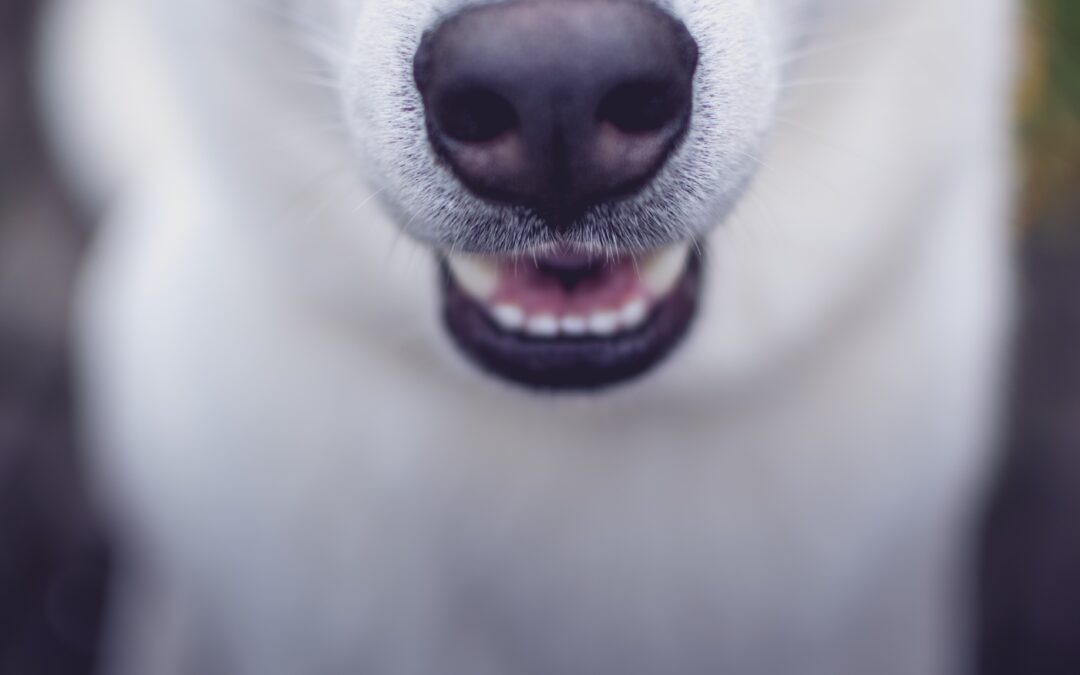One of the first things your vet will examine when looking at your dog during a check-up will be inside his/her mouth. There are a number of things that become evident very quickly and can indicate not only dental disease but also diseases involving other body systems.
We start by asking ourselves the following questions –
Does the dog have bad breath?
This can indicate gut disease, kidney disease and diabetes to name a few.
Is the gum colour normal and does blood return to the gums quickly if the tissue is depressed?
Increased redness can be an indication of toxicity or an infection, pale gums are often associated with pain or anaemia, while slow return or refill when pressed could indicate poor blood pressure. Some animals’ gums are more pigmented (or blackened) compared to others, while some breeds present an orange gum which can indicate jaundice associated with liver disease in other breeds. And we haven’t even mentioned the teeth yet!
In most typically healthy animals, the gums will be a bubble-gum pink colour and when pressed blood should return within 2 seconds. Get to know your dog when he or she is healthy and at rest to ensure you know what their normal is.
Now down to the teeth.
We know that 80% of dogs will have some form of dental disease by the time they are 6 years of age. It may be as simple as some plaque build-up or slightly inflamed gums; others will have fractured crowns. Periodontal disease is an extension of gingivitis, an inflammation or receding of the gums that allows infection to loosen the supporting structures of the teeth.
Just as in people, plaque (the bacterial film) and tartar (the hard build up) are the usual culprits that start the process. While dry food does scrape away some plaque, and raw, meaty bones or dental treats also can help, there’s no substitute for brushing your dog’s teeth. I recommend starting early with young dogs. If brushing is introduced as part of early socialization and training, it’s accepted with little hassle. With older dogs it’s more of a problem, yet most well-trained dogs soon accept the brushing. You can use an old face washer over your finger with a little Pet flavoured tooth paste, or silicon/rubber brushed that sits over your finger. Try to clean both the inside and outside surface of the teeth.
If you have an older dog, start with a trip to your veterinarian, ask him to clean the dog’s teeth under anaesthetic and then keep them clean from there. They can also show you the best way to brush, and discuss different options of products to use. The frequency will depend on your commitment, but daily brushing is our recommendation.
Our aim is to ensure your dog does not miss a day’s play because of a tooth root abscess or possibly develop heart disease brought on by infection from gum disease entering the bloodstream (which can result in endocarditis – inflammation of the membrane of the heart) or damaged heart valves.
Fractured teeth are also common in dogs. Breaking off the crown tip of the tooth can cause a few issues. It may allow decay to set in, expose dentine (the layer with the canals that run down to the nerve) causing sensitivity, and then worst case exposure of the nerve pulp leading to significant pain and risk of an infection through to the root. Extraction or removal of painful teeth is an option. These days there are also veterinary dental specialists that may be able to repair damaged teeth with fillings and root canals etc., just the same as in humans.
Lastly, we will look in your pups mouth for tumours. Many of the tumours we find in the mouth are particularly nasty. Although the risk for most tumours increases with age, most veterinarians will advise a biopsy of any mass in the mouth regardless of age. One of my own dogs developed a bone tumour in the front of the jaw at only 14 months, it was extremely aggressive and terminal within one week from diagnosis, with the only initial sign being a loose front tooth and darkened gum attached to it. Some lumps are benign and can be triggered by long standing infections. So it is always best to know what you are dealing with so your vet can help you take the most appropriate course of action for you and your dog.
Signs of dental disease could be a loss of appetite, bad breath, pawing at the mouth, excessive or bloody salivation, chewing on one side more than the other or difficulty in swallowing.
Preventative products are readily available and can sometimes cause confusion. In my experience, brushing is always best as a preventative measure, followed by offering our pooch raw, meaty bones. Make sure the bones have plenty of meat and chewy bits on them, not just the hard bone. I prefer to offer ribs, brisket, spines, (neck to tail), shoulder blades and pelvis bones. I find the leg bones are often too hard and can fracture the enamel off the tooth surface, especially on those big back teeth.
Dental chews should contain products that prevent the build-up of bacteria. Oravet chews contain a product called delmopinol, which when fed daily aid in preventing plaque build-up. Delicate Care makes a treat and a dry pellet that contains similar products along with Yucca fibre to scrub the teeth.
In my book, an ounce of prevention when it comes to your dogs’ dental health is better than any cure. If you’d like to book in a for FREE dental health check-up throughout August with one of our Direct Vet Nurses, or if it’s time for a clean for your four-legged friend, drop us a line at the clinic on 03 9369 1822 to discuss your appointment, preparation and procedure.


